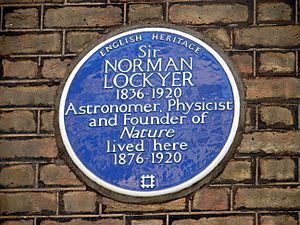Norman Lockyer facts for kids
Quick facts for kids
Joseph Norman Lockyer
|
|
|---|---|

Sir Joseph Norman Lockyer, c. 1897
|
|
| Born | 17 May 1836 Rugby, Warwickshire, England
|
| Died | 16 August 1920 (aged 84) Salcombe Regis, Devon, England
|
| Nationality | British |
| Known for | Discovery of helium Founder of Journal, Nature |
| Awards | Rumford Medal (1874) Janssen Medal (1889) |
| Scientific career | |
| Fields | Astronomy |
| Institutions | Imperial College London |
Sir Joseph Norman Lockyer (born May 17, 1836 – died August 16, 1920) was a famous English scientist and astronomer. He is best known for discovering the gas helium with French scientist Pierre Janssen. Lockyer also started and was the first editor of a very important science magazine called Nature.
Contents
About Norman Lockyer
Lockyer was born in Rugby, Warwickshire, England. His father helped him learn about science early on. After school and some travel, he worked for the British government. He later moved to Wimbledon with his wife, Winifred James. She helped translate many French science books into English.
Lockyer loved studying the Sun as an amateur astronomer. In 1885, he became the first professor of astronomical physics. This was at the Royal College of Science, which is now part of Imperial College. He led research there until 1913. A special observatory was built for him at the college.
Studying Light and Stars
In the 1860s, Lockyer became very interested in spectroscopy. This is a way to study light to figure out what things are made of. He used a telescope from his home in West Hampstead for his research.
Discovering Helium
In 1868, scientists saw a bright yellow line when they looked at the Sun's light. This line was different from any known material on Earth. Lockyer suggested that this yellow line came from a new element found only on the Sun. He named this element helium, from the Greek word 'Helios', meaning 'sun'.
Another scientist, Pierre Janssen, also saw this yellow line around the same time. Because their discoveries reached the French academy on the same day, they both get credit for finding helium. Helium was later found on Earth about 27 years later. Lockyer worked with chemist Edward Frankland on this discovery.
Starting Nature Magazine
To help scientists from different fields share their ideas, Lockyer started a science magazine called Nature in 1869. He was the editor of this magazine until just before he passed away. Nature is still a very important science magazine today.
Observing Solar Eclipses
Lockyer led eight trips to watch solar eclipses. For example, he went to Sicily in 1870 and to India in 1871 and 1898. These trips helped him learn more about the Sun.
Studying Ancient Sites
Lockyer was also one of the first people to study archaeoastronomy. This is the study of how ancient people used astronomy. In 1890, he noticed that many ancient temples in Greece and Egypt were built facing the sunrise or certain stars.
He believed that the Heel-Stone at Stonehenge in England was lined up with the sunrise in midsummer. Based on this, he estimated that Stonehenge was built around 1680 BC. Later, scientists used radiocarbon dating and found a date of 1800 BC, which was very close to Lockyer's estimate. He also studied how the Parthenon in Greece was aligned with the Pleiades star cluster. He wrote a book called The Dawn Of Astronomy about his work on Egyptian temples.
His Later Life and Legacy
Lockyer's first wife, Winifred, passed away in 1879. They had six sons and two daughters. In 1903, Lockyer married Mary Thomasina Brodhurst.
After he retired in 1913, Lockyer built an observatory near his home in Salcombe Regis, England. After he died, this observatory was renamed the Norman Lockyer Observatory in his honor. His son, William J.S. Lockyer, directed it for a time. Today, it is run by a society and is a place where people can learn about astronomy.
Sir Norman Lockyer passed away at his home in Salcombe Regis in 1920. He was buried in the churchyard of St Peter and St Mary there.
Honours and Awards
- Fellow of the Royal Society (1869)
- Janssen Medal from the French Academy of Sciences (1875)
- Knight Commander of the Order of the Bath (1897)
- President of the British Science Association (1903 – 1904)
- Two craters, one on the Moon and one on Mars, are named Lockyer after him.
See also
 In Spanish: Norman Lockyer para niños
In Spanish: Norman Lockyer para niños



